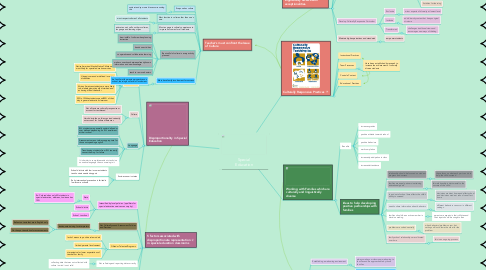
1. Disproportionality in Special Education
1.1. Race/Ethnicity
1.1.1. Native American/Alaska Native Children are most likely for special education services
1.1.2. Hispanics are under defined in certain disabilities
1.1.3. African American students are more likely to be labeled emotionally disturbed and as having difficult behavior
1.1.4. 55% of White students spend 80% of their day in general education classroom
1.2. Culture
1.2.1. Not all tests are culturally responsive or account for test biased
1.2.2. Harsh discipline policies can inadvertently not account for culture differences
1.3. Language
1.3.1. ELL students are generally under defined or over defined depending on ELL enrollment at their school
1.3.2. Assessments are not always appropriate for those not speaking english
1.3.3. Transitioning students from ELL too early can set them up for failure
1.3.4. It is harder to complete academic tasks in a nonnative language than conversing in it
1.4. Socio-economic status
1.4.1. School districts with low income students tend to strain needed support
1.4.2. Early intervention/prevention is limited in low income schools
2. Teacher's must confront the Issue of Culture
2.1. Everyone has culture
2.1.1. understand your own biases surrounding this
2.2. Must function in culture other than one's own.
2.2.1. must respect culture of all students
2.3. Must engage in cultural competence to improve outcomes for all students
2.3.1. educate one's self on others cultures, language and learning styles
2.4. Be mindful of culture in every activity planned
2.4.1. be mindful of culture when planning instruction
2.4.2. hands on activities
2.4.3. cooperative and collaborative learning
2.4.4. make connections between already known information and new knowlege
2.4.5. teach to remove barriers
2.5. Must have family involvement for success
2.5.1. be familiar with parents perspectives on school, learning and level of involvment
3. 5 factors associated with disproportionate representation in special education classrooms
3.1. Intensified by local policies. (qualifiers for special education services can vary by):
3.1.1. State
3.1.1.1. Ex: Colorado has only 4% students in special education, whereas, Louisiana has 12%
3.1.2. School district
3.1.3. School to school
3.2. Not Culturally sound Assessment Policies and Practices
3.2.1. Inadequate training for interpreters
3.2.1.1. Reliant on tests that are in English only
3.2.1.2. On-the-spot translation for assessements
3.3. Gifted or Talented Programs
3.3.1. lack of access to positive role models
3.3.2. limited parental involvement
3.3.3. stereotypical or lower expectations of teachers or family
3.4. Not collecting and reporting data correctly
3.4.1. collecting data that was not collected with culture in mind is not valid
3.5. Definitions are not consistent
3.5.1. disabilities are not always defined consistently
3.5.2. can vary widely across states, in state, among districts and even within districts
4. Working with Families which are culturally and linguistically diverse
4.1. Benefits
4.1.1. increases grades
4.1.2. positive attitude towards school
4.1.3. positive behaviors
4.1.4. work completion
4.1.5. increased participation in class
4.1.6. increased attendance
4.2. Ideas to help developing positive partnerships with families
4.2.1. relationship should be focused on student progress and success
4.2.1.1. these focus on what each part can do to help the child succeed
4.2.2. families are equal partners in attaining educational goals
4.2.2.1. this relationship is detrimental to the success of the child
4.2.3. In and out of school time affects the child's ability to succeed
4.2.3.1. decisions made at home and affect school and decisions made at school can affect home
4.2.4. need to share information about behaviors
4.2.4.1. different behaviors can occur in different settings.
4.2.5. families should be an active member in decision making
4.2.5.1. parents are experts in their children and their input should be sought often
4.2.6. problems are solved neutrally
4.2.6.1. when behaviors/problems occur, bot settings will not blame the other for the problem
4.2.7. family-school relationships are cultivated over time
4.2.7.1. this is an ongoing process
5. Culturally Responsive Practices
5.1. Instructional Practices
5.2. Team Processes
5.2.1. Have been established by research to increase the achievement of culturally diverse students
5.3. Curricula Content
5.4. Educational Practices
6. Strategies for working with students who are culturally and linguistically diverse with exceptionalities.
6.1. Early intervention and response to intervention is key to success
6.1.1. Developing interventions that is successful across all cultures.
6.2. Performing assessments using a CHC Cross-Battery Approach
6.2.1. allows for evaluating cognitive abilities of all individuals from diverse backgrounds and cultures.
6.3. Use Cultural Responsive Pedagogy
6.3.1. Must account for cultural diversity in
6.3.1.1. Course conceptionalization
6.3.1.2. Objectives
6.3.1.3. Learning Materials
6.3.1.4. Activities for learning
6.4. Develop Culturally Responsive Curriculum
6.4.1. Exclusive
6.4.1.1. minor aspects of diversity at lowest level
6.4.2. Inclusive
6.4.2.1. add diversity content but keeps original structure
6.4.3. Transformed
6.4.3.1. challenges traditional views and encourages new ways of thinking.
6.5. Maintain high expectations and standards
6.5.1. empower students
7. Strategies for Empowering families
7.1. Establishing a welcoming environment
7.1.1. always make your classroom welcoming to families and be approachable by those families
7.2. Implementing effective communication strategies
7.2.1. find an effective communication strategy to perform consistent and effective communication between home and school
7.3. Resolving conflicts
7.3.1. try to present conflicts as win, win so that the success of the child is always steering the conflict
7.4. Including families in problem solving and decision making
7.4.1. this promotes conversations centered around the child's achievement and success
7.5. Enhancing learning from home
7.5.1. communicate on what could be supported at home concerning academics and behaviorally

